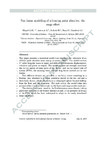Non-linear modelling of a heaving point absorber: The surge effect
| dc.contributor.author | Miquel, AM | en |
| dc.contributor.author | Antonini, A | en |
| dc.contributor.author | Archetti, R | en |
| dc.contributor.author | Bozzi, S | en |
| dc.contributor.author | Lamberti, A | en |
| dc.date.accessioned | 2017-09-15T13:29:48Z | |
| dc.date.issued | 2017-09-01 | en |
| dc.identifier.issn | 2214-1669 | en |
| dc.identifier.uri | http://hdl.handle.net/10026.1/9933 | |
| dc.description.abstract |
© 2017 Elsevier Ltd. All rights reserved. This paper presents a numerical model that simulates the behaviour of an offshore point absorber wave energy converter (WEC). The model receives 1st order irregular waves as input and delivers instantaneous displacements, velocities and power as output. The model outputs are strongly non-linear due to the nature of some parts of the device, such as the power take off system (PTO), the mooring wires and the drag forces exerted on the wet bodies. Two different devices are modelled, a two-body device consisting in a floating buoy attached to a linear generator placed at the sea bed and a three-body device, which also includes a submerged sphere located halfway from the float and the generator. For each device, the model takes into account either the heave mode only or the heave and surge modes combined. The devices have been tuned to the Mediterranean wave climate, taking particular attention to the floater dimensions and to the geometrical design of the PTO, which has been redesigned to adapt to the newly introduced surge conditions. For the two-body device, although the dynamic behaviour changes when the surge is included, no relevant differences are observed regarding the power production. When studying the three-body device, results show two clear trends. For high waves, the surge leads to a decrease in the production, whereas for smaller waves it affects positively the power absorption. Overall, the negative contribution is more relevant but also less frequent, leading to no substantial change in the power production. Including the surge mode in the model does not give significant variations in production rates and therefore, may be neglected only for energy production assessment. However, it should always be taken into account at the design stage. | en |
| dc.format.extent | 95 - 109 | en |
| dc.language.iso | en | en |
| dc.title | Non-linear modelling of a heaving point absorber: The surge effect | en |
| dc.type | Journal Article | |
| plymouth.volume | 19 | en |
| plymouth.publication-status | Accepted | en |
| plymouth.journal | International Journal of Marine Energy | en |
| dc.identifier.doi | 10.1016/j.ijome.2017.07.002 | en |
| plymouth.organisational-group | /Plymouth | |
| plymouth.organisational-group | /Plymouth/Faculty of Science and Engineering | |
| plymouth.organisational-group | /Plymouth/REF 2021 Researchers by UoA | |
| plymouth.organisational-group | /Plymouth/REF 2021 Researchers by UoA/UoA12 Engineering | |
| dcterms.dateAccepted | 2017-07-17 | en |
| dc.rights.embargodate | 2018-07-22 | en |
| dc.rights.embargoperiod | 12 months | en |
| rioxxterms.versionofrecord | 10.1016/j.ijome.2017.07.002 | en |
| rioxxterms.licenseref.uri | http://www.rioxx.net/licenses/under-embargo-all-rights-reserved | en |
| rioxxterms.licenseref.startdate | 2017-09-01 | en |
| rioxxterms.type | Journal Article/Review | en |


